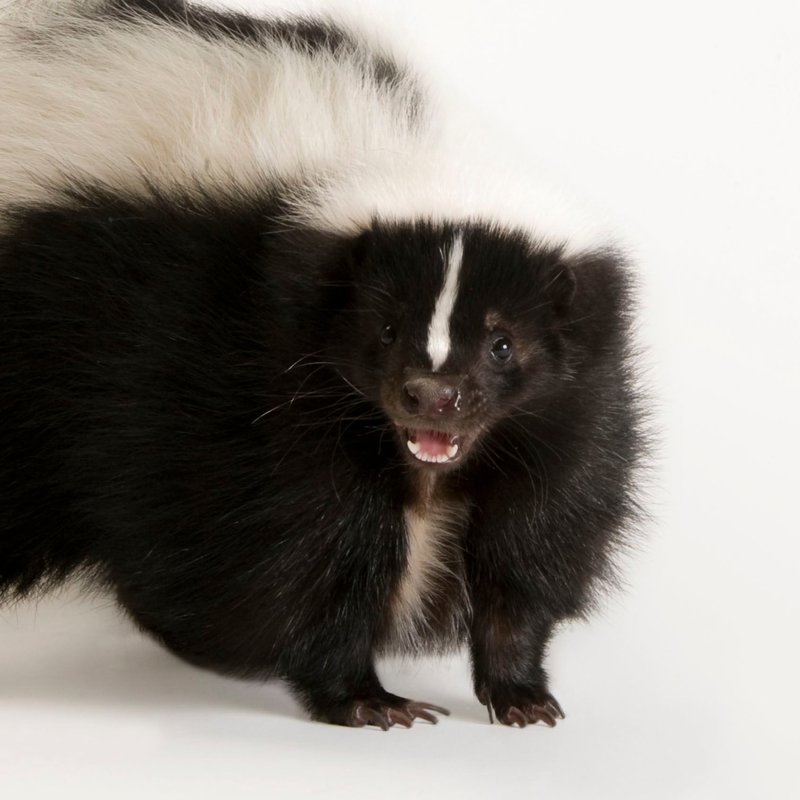
Think of skunks as the shy introverts of the animal kingdom. They’d much rather avoid confrontation than spray you with that notorious odor. So, understanding their behavior will help keep both you and the skunk safe. In this article, we’ll walk through how to react if you meet a skunk in the wild, shedding light on their habits, how to avoid surprising them, and what steps to take if things go sideways.
Understanding Skunk Behavior
To handle an encounter with a skunk effectively, it’s vital to understand their behavior. Skunks are generally non-aggressive and prefer to scurry away rather than engage. They often rely on their *strong sense of smell* as a defense mechanism. If you see a skunk, it’s usually busy foraging for food, like insects or small plants. They are nocturnal creatures, which means they’re most active at night, making daytime encounters less common but not impossible.
When feeling threatened, skunks will often display defensive behaviors before resorting to spraying. They might stomp their feet, raise their tails, or even hiss. These are their warning signs, so if you notice these actions, it’s a clear signal that you should give them plenty of space. Here’s the thing: skunks don’t want to use their spray, as it can be a *painful experience* for them as well. So, by understanding this, you can gently navigate the situation.
Signs of a Skunk Encounter
Recognizing signs of a potential skunk encounter is key to staying calm. If you’re hiking or camping in areas known for wildlife, keep an eye out for specific indicators:
- Tracks: Look for small, hand-like paw prints with five toes.
- Burrows: Check for holes in the ground, often near bushes or logs.
- Foul Odor: If you catch a whiff of something strong and musky, a skunk may be nearby.
Being aware of these signs can prepare you for a potential encounter. When you understand skunk behavior and the signs they leave behind, you’re one step ahead.
How to Safely React to a Skunk Encounter
So, you’ve spotted a skunk. What now? Don’t panic. The first step is to remain calm and silent. Sudden movements or loud noises can startle the skunk, leading to a defensive response. If you’re with others, gently communicate to them the importance of staying quiet.
Next, assess the distance between you and the skunk. As a rule of thumb, if you’re more than 10 feet away, you’re safe. If you find yourself closer, slowly back away. Avoid turning your back on the skunk; instead, move sideways. This posture allows you to keep the skunk in your line of sight while not appearing threatening.
If the skunk doesn’t seem alarmed and continues on its path, let it be. Skunks are creatures of habit, and if left undisturbed, they’ll likely carry on with their business.
What to Avoid Doing
When encountering a skunk, there are definitely things you should steer clear of. Here’s a list of actions that can make situations worse:
- Don’t corner a skunk: If they feel trapped, they’re more likely to spray.
- Avoid sudden movements: Quick movements can trigger their flight response.
- Don’t try to scare it away: Yelling or throwing things can provoke the skunk.
Keep in mind, brief encounters can turn sour if you act too aggressively. Your primary goal is to diffuse the situation and allow the skunk to escape safely.
What If a Skunk Sprays You?
In the unfortunate event that you do get sprayed, don’t worry; there are ways to handle it. First, it’s important to stay calm. Skunk spray contains a chemical called *thiol*, which creates that potent odor. If you’re close enough to be sprayed, you’ll want to act fast to limit the stink’s duration.
Start by moving away from the spray area. The longer you linger, the more the smell will cling to you. Once you’re at a safe distance, wash the affected area with soap and water immediately. If you want to neutralize the odor more effectively, consider mixing hydrogen peroxide (3%), baking soda, and dish soap into a paste. Apply it to the affected area, let it sit for about five minutes, and then rinse thoroughly. This can help cut through the odor.
If the spray has landed on your clothes, a vinegar soak might also help. Simply mix equal parts water and vinegar before washing. It’s best to avoid hot water, as it can set the odor. Here’s the thing: the sooner you address the smell, the easier it will be to eliminate.
Preventing Skunk Encounters
While sometimes you can’t avoid a skunk encounter, there are steps you can take to reduce the likelihood of one happening. If you’re camping or spending time outdoors, try these tips:
- Keep food secured: Use airtight containers and dispose of scraps properly to avoid attracting skunks.
- Stay on paths: Stick to well-traveled trails to minimize unexpected encounters.
- Make noise: If you’re in a group, chatting and laughing can ward off wildlife, including skunks.
Implementing these simple precautions can help you enjoy your outdoor adventures without unwanted surprises.
Creating a Safe Environment
If you’re frequently in areas where skunks roam, consider creating a safe environment. This might mean:
- Securing your campsite: Store food away from sleeping areas and keep trash cans tightly closed.
- Using repellent: Some natural repellents can deter skunks from coming too close.
- Educating others: Share information about skunk behavior with your group to ensure everyone knows what to do.
A little preparation can make your experience in the wild much more enjoyable and safer.
Encounters with skunks in the wild can be surprising, but they don’t have to be stressful. By understanding skunk behavior, reacting calmly, and taking the right precautions, you can navigate these moments smoothly. Remember that skunks are more interested in going about their business than bothering you.
So the next time you find yourself unexpectedly face-to-face with a skunk, take a deep breath. Move slowly, back away if necessary, and allow the skunk to continue on its way. With this knowledge in your back pocket, you’re well-prepared for a safe and pleasant experience in nature. Happy exploring!

